Clinical Center celebrates special day honoring NIH teachers
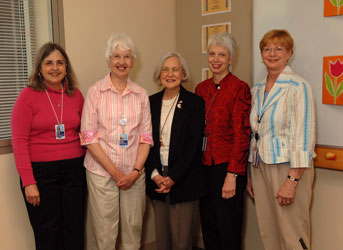 |
NIH Children's School teachers (l to r) Anita Field, Anne Wasson, Helen Mays, Susan Job and Ann Davidson tend to educational needs of Clinical Center patients.
|
When children come to the Clinical Center to participate in mental health research protocols, they are dealing with a number of challenges, anxieties and emotions. But thanks to NIH's education program, schoolwork is not added to the list of concerns. Two teachers at the CC help these young patients keep up with school assignments from back home and play important roles in their students' progress in clinical research.
Those special people are schoolteachers Ann Davidson and Susan Job. On April 26, they joined fellow NIH teachers Helen Mays, Anne Wasson and Anita Field for an informal luncheon, organized by 1SW's behavioral-health specialist Andre Caple, honoring them as part of National Teacher Appreciation Week.
The Clinical Center has two distinct education programs for CC patients who are on-site to participate in research. Both programs operate under the auspices of the NIH Children's School, which offers one classroom for the general pediatric population and a second classroom reserved for those young patients in behavioral health protocols.
"Right now there are three active protocols for children on the mental health unit," says Davidson. "They focus on mood dysregulation, bipolar disorder and early onset psychoses." Davidson and Job are responsible not only for helping these patients keep up with their academic studies, but also for observing how they behave in the classroom as part of the research program.
Each day, they welcome, on average, six students to the classroom on the 1SWN corridor of the Hatfield Center. Because it is a locked unit, the behavioral health unit houses its own classroom while the NIH Children's School classroom is open on the 1SWS unit for children to use as needed.
Class for the bipolar and mood dysregulation students begins at 9 a.m. and includes an education period and quiet time for working on homework. By the afternoon, the first student group leaves the classroom for recreational therapy, music therapy and other programs, and the second group of students, from the early onset psychoses protocol, comes for the second half of the day.
After each class session, Davidson and Job ask the students to share how they think they did in class. "Some will be honest and tell us they thought they were distracted or did well," says Job. "Others will be in a total state of denial." But it is an important part of keeping the students involved and mindful of their behaviors. In addition, the two teachers will spend their lunch hour and after-school time completing forms that detail the child�?s behavior and attitude and any other observations that might be important to the research team in determining diagnoses and appropriate medicine dosages.
"The teachers here are dedicated to teaching and to the students," says Caple. "Every effort is made to keep students working in their own curriculum and out of their own textbooks."
"These students need a lot of support and a lot of one-on-one attention to stay on task and tackle challenges," Davidson says. "Basically we are maintaining their academic needs while recognizing they have significant challenges," Job adds.
The goal is to keep students on track with their schoolwork so when they return to their home schools they have not fallen behind. Davidson and Job maintain close contact with the patients�? teachers, which they say is important so teachers understand how the academic pace at NIH may differ from the classroom back home.
"We have kids from all different grade levels," explains Job. "To keep them on the same academic program for their grade would not be fair, especially when they have been withdrawn from all their usual medications. The school approach is flexible to meet their current level and changing needs."
For most teachers, the idea of working in such a challenging environment is less than ideal. But for Davidson and Job, this is the work they feel they were meant to do, and they have been excelling at it for decades. Davidson has been at the CC for 21 years, and Job has been here 14.
They both say that the team approach to teaching is what makes the work so enjoyable. From the therapists to the nurses, to the other NIH teachers, Davidson and Job say those relationships make the job especially meaningful.
"No one can do it alone," Job says. "We all work together," Davidson notes. "It is such a supportive environment."
Read more about the NIH Children's School in the June issue of CC News.
—Kathryn Boswell
Back to Top
Nutrition Department hosts program with research focus
About 80 dietetic interns, registered dietitians, graduate students and nutrition professors gathered on the NIH campus on March 23 for Nutrition Research Day.
Hosted by the CC Nutrition Department, the annual event brings area dietetic interns to NIH to
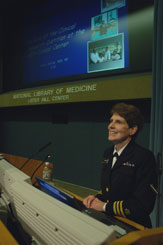 |
Nancy Sebring speaks to visiting students at Research Day about a dietitian's role at the CC.
|
introduce them to the world of federal nutrition research and—more specifically—the role of research dietitians at the CC. This year, Research Day was coupled with the NCI Division of Cancer Prevention's weeklong nutrition practicum, which offered dietetic interns and visiting students and professors the opportunity to participate in an intense, five-day learning session and gain practical experience as part of their academic program.
The NCI practicum addressed cancer prevention topics and activities, cancer trends, bioactive food components, the role of garlic and tea in cancer prevention, nutrigenomics, ethics and health-related messages. Speakers discussed how certain foods could increase the risk of developing cancer—for example, addressing the benefits of eating more of one type of fat and less of another to decrease the risk of cancer as well as the cancer prevention benefits of fiber and green tea.
Nancy Sebring, a clinical research dietitian, kicked off the morning portion of Research Day by describing the research protocols and nutrition services provided at the CC. She gave students a glimpse into the daily life of a CC dietitian, describing how many of them split their time between patient care and research support. Other dietitians then described their involvement in research studies, including specific research diets and pediatric obesity protocols.
"This program introduces students to the research process and a dietitian's role in that process," says Maureen Leser, director of the NIH dietetic internship. "It also gives the clinical research dietitians at NIH an opportunity to showcase some of their specialized knowledge and skills, such as the development of dietary intake assessment tools and tips for evaluating patient-use of herbal and botanical supplements."
In addition, Dr. Susan Yanovski, director of the obesity and eating disorders program at NIDDK, described the Look AHEAD study, which is examining the effect of decreased caloric intake and exercise on long-term weight control and risk of type 2 diabetes. Margaret McDowell, a CDC expert research officer, reviewed the role of registered dietitians in the National Health and Nutrition Examination Survey. Dr. Patricia Guenther, Center for Nutrition Policy and Prevention, USDA, presented current research being conducted to revise the Healthy Eating Index—a web-based interactive nutrition tool available to consumers.
Students were also treated to tours of the new NIH Clinical Research Center and attended workshops led by CC dietitians. Workshops addressed dietary assessment, botanical and herbal supplements, the organization and function of a research kitchen and body composition analysis for research studies.
—By Kathryn Boswell
Back to Top
American College of Physicians honors CC's Gallin and NHLBI's Young
Two NIHers were honored during the American College of Physicians annual convocation program in Philadelphia on April 6.
Dr. John I. Gallin, CC director, received a prestigious Rosenthal Award for his "contribution to the advancement of clinical research, to the teaching structure, to the principles of patient care and to the overall productivity of hospital programs." Dr. Neal S. Young, chief of the hematology branch in NHLBI's intramural program, was cited for his election as a Master of the American College of Physicians, which recognizes outstanding career accomplishments and contributions.
The Rosenthal awards, established in 1976 by the ACP Board of Regents, are given annually in two distinct categories. The first (R1) recognizes a "physician-scientist, clinician or scientific group whose recent innovative work is making a notable contribution to improve clinical care in the field of internal medicine." The second (R2), which Gallin received, goes to an "individual or organization whose recent original approach in the delivery of health care or in the design of facilities for its delivery will increase its clinical and/or economic effectiveness." During the program, Gallin was introduced as an active clinician and researcher who has "raised the already excellent Clinical Center to higher standards and levels of accomplishment."
Other NIH researchers and administrators who also have been honored with Rosenthal awards include Dr. Robert C. Gallo, previously at NCI (R1, 1988), Dr. Francis S. Collins, NHGRI (R1, 1993), Dr. Anthony S. Fauci, NIAID, (R1, 1995) and Dr. Griffin P. Rodgers, NIDDK (R2, 1999).
Back to Top
Event offers youngsters an up-close look at science
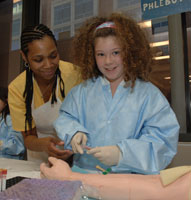 |
Kelley Smith (l) teaches Marti Weiner (r) how to draw blood at the CC laboratory medicine event.
|
The Clinical Center was teeming with children on April 27 for NIH's Take Your Child to Work Day. It was a full day of elaborate presentations and hands-on activities that allowed children the opportunity to learn how to draw blood, record their movements in the state-of-the-art clinical movement analysis laboratory, perform CPR on the mannequin "Mr. Simmons" and touch everything from a pigs lung to a microscope, just to name a few of the 47 activities that were offered throughout the NIH campus by various institutes.
Coordinated by the Office of Equal Opportunity and Diversity Management, the annual event is designed to introduce children to the world of biomedical research and to the wide array of skills and services needed to support it. A record number of participants were happy to don a lab coat and get to work in the lab for this year's program.
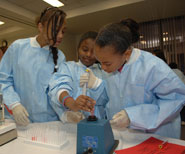
The Department of Laboratory Medicine invited children to perform clinical tests, identify blood cells and microorganisms and use the laboratory equipment.
|
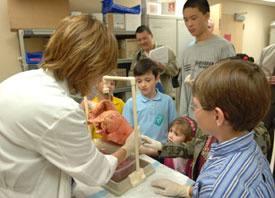
Renee Granrud, Critical Care Medicine, invites a group of of willing participants to feel the difference between the lung of a healthy pig and one that had been exposed to cigarette smoke.
|
Back to Top
CC designs training to improve employee management
What are the rights and responsibilities of managers and supervisors? What are the rights and responsibilities of employees? What can a supervisor do if an employee's behavior is inappropriate? What can he or she do if an employee is not performing assigned work?
Many managers come into their jobs without clear and accurate answers to these questions. They learn as they go, and often receive faulty advice on how to handle employee problems. As a result, the Clinical Center has instituted a four-day training program for managers and supervisors.
The new training program is part of a larger effort to improve performance management at the Clinical Center, noted Maureen Gormley, CC chief operating officer. "Our approach also includes expert consultative services for managers. Simply put, we have to make sure individual employees work effectively and efficiently and that managers understand how to encourage and support that goal. We are committed to maintaining quality service even when faced with having fewer employees and declining budgets."
"The purpose of this new course is to give managers and supervisors a basic understanding of the federal performance and disciplinary process," said Dr. Deborah Gardner, chief of the CC Office of Workforce Planning and Development. It also offers communication strategies for better conversations between managers and supervisors. "Trust is at the heart of effective performance management," Gardner explained. "Managers and supervisors have to deliver constructive feedback for employees to develop skills and commit to their daily work."
Since it was launched in January, 121 managers and supervisors have taken the course. "The response has been overwhelmingly positive," said Gardner. "Participants have reported that the course has made them feel empowered, and that they wish they had had this information when they were new managers."
The course helps managers write effective performance standards and rate their employees on those standards. (Performance standards should be observable, measurable, attainable and reasonable.) It helps managers identify employee performance and conduct problems, and provides examples of how to improve employee/supervisor interactions.
"A bad manager is one who treats bad employees better than good employees," said William N. Rudman, an attorney who specializes in federal employment law. Rudman, who is also a retired federal employee, leads the section of the course dealing with employee performance and conduct issues. He explains how to identify misconduct and performance problems and deal with them in legal and appropriate ways.
The course coincides with a new performance management appraisal program, which will be instituted HHS-wide in June. The new program has a four-tiered rating system: exceptional, fully successful, minimally successful and unacceptable. This differs from the current system that is pass/fail. Based on ratings, employees will be eligible for performance awards at the conclusion of the performance rating cycles. Rating cycles will continue to be based on the calendar year.
Details on the new plan are being communicated to all employees through HHS all-hands meetings and e-mails. Performance liaisons have been designated for each IC to assist in communications and serve as resources for implementation of the new performance program. The Clinical Center performance liaisons are Gardner (dgardner@cc.nih.gov) and Hillary Fitilis (hfitilis@cc.nih.gov). There will also be mandatory online training for employees and supervisors sponsored by HHS and a series of meetings, both on and off campus, will provide guidance and answer questions.
The CC management training course is scheduled to continue through June. Managers and supervisors who have not taken the training should contact Yasmin Coates at ycoates@cc.nih.gov to register.
—Colleen Henrichsen
Back to Top
CC's new intranet gives staff better access to information
The Clinical Center has launched a new intranet site to make it easier for staff to find the information they need to do their jobs. The site can be accessed at
http://intranet.cc.nih.gov
or from the "Staff Only" link at the upper left side of the CC home page.
Information is categorized according to the main activities of the Clinical Center; the tasks that staff members are faced with every day. The new format also brings valuable information to the surface that was previously available but often buried several layers deep. It is more complete and better organized than the previous "Staff Only" page.
The new site also provides a foundation for the development of department-level intranet pages since there is now an appropriate place for these pages to be linked. In addition, the page puts the CC in line with OMB policies, which state that government agencies should use intranets for information directed to employees.
The CC Office of Communications encourages staff members to make the intranet their browser default home page by following the steps below.
For PC's on Internet Explorer:
1. Open your Internet Explorer browser.
2. Click on Tools from the top menu.
3. Select Internet Options, which will open an Internet Options window.
4. Under the General tab there is a section called Home page. In the address box type http://intranet.cc.nih.gov
5. Click the Apply button for the change to take effect.
6. Click the OK button to close the Internet Options window.
For Macs on Internet Explorer:
1. Open the Internet Explorer browser
2. Click on Explorer from the top menu
3. Click on Preferences
4. Under Web Browser (left side menu), select Browser Display
5. Under Browser Display there is a section called Home Page. In the Address box type in http://intranet.cc.nih.gov
4. Check the box that reads Automatically go to this Home Page when opening a new window.
5. Click OK.
CC employees interested in participating in a usability study of the intranet should contact Colleen Henrichsen, chenrichsen@nih.gov.
Back to Top
CC employee's mother donates handmade dolls to pediatric unit
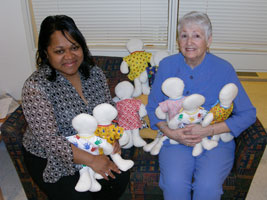 |
Dorothy Wilson (right), mother of CC employee Debra Byram, worked for six weeks to create the 100 handmade dolls she donated to CC pediatric patients. Felicia Andrews (left), nurse manager, accepted the gift on behalf of the pediatric unit.
|
When Dorothy Wilson and her husband, Jerry, set out on their trip from Michigan to Maryland to visit their daughter Debra Byram, senior administrative officer in the CC Office of Administrative Management, they packed all the essentials for their trip. They also brought along some very special cargo—100 handmade dolls to donate to the Clinical Center's pediatric patients.
"The car was so packed with dolls, we were worried there wouldn't be room for our clothes," Wilson says with a laugh.
For years, Wilson and the other women in her condo association group in Michigan have been meeting every Wednesday to sew and stuff gingerbread-man-shaped dolls, which they deliver to pediatric patients at local hospitals.
Before coming to visit her daughter at NIH, Wilson asked Byram to contact the Clinical Center's pediatric unit to ask if a number of dolls would be a helpful donation for their patients. Felicia Andrews, nurse manager, was happy to accept the gift, and Wilson went to work. After six weeks of sewing and stuffing, she completed 100 dolls and corresponding little hospital gowns in various patterns and colors. She delivered the dolls on March 31.
"When children come back to their hospital rooms after surgery, the dolls are waiting on their beds for them," Wilson says.
"We will use the dolls for medical play," explains Andrews. "The children can take markers and draw faces on the dolls to express their own feelings or just design the face how they want it to look."
In addition to personalizing the dolls, patients can perform the same procedures on the dolls that they will undergo themselves, or doctors can use them to demonstrate what a surgery will involve. "It helps eliminate some of the fear and anxiety," Andrews notes.
Back to Top
Human Resources innovations among Reed's career highlights
After 34 years of federal service at NIH and the Clinical Center, Tom Reed, senior human resources advisor, has retired.
Prior to his current position, Reed was director of the CC Office of Human Resources Management, where he supervised personnel and training staff.
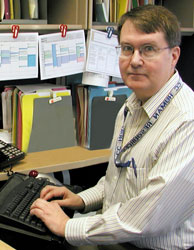 |
For more than three decades, Tom Reed has been serving the human resources needs of NIH and CC employees.
|
At the beginning of his career, while at what is now the NIDCR, Reed developed an innovative computer program that calculated retirement annuities for NIH’s civil service staff. After many years in use, the program was succeeded by an official federal application designed for government-wide use. Reed is proud that his original program blazed the trail for today’s modern system. “Computers weren’t widely used when we developed ours,” he said. “But there was still a need. It was something that just wasn’t available in most other places.”
Reed later moved to NCI’s personnel office and subsequently was selected for their Administrative Career Development Program with one-year assignments in budget, grants management and general administration.
In the mid-1980s, after accepting a job at the CC, Reed was able to influence a much-needed reform in a key civil service law that would allow the CC to improve nurses’ salaries (and later those of allied health staff) using the authorities of the Veterans Administration (Title 38). In 2001, further human resource improvements were made using Title 42 (the Public Health Service Act) to pay and appoint clinical research support staff engaged in direct or indirect services related to clinical patient care.
“This new personnel system was centered around pay bands that used competency—not longevity—to determine individual pay increases and supplemental pay in the form of awards, bonuses and other recognitions given to employees,” explains Reed. “It also allowed us to dramatically streamline the procedure to appoint staff, cutting weeks and lots of paperwork off the normal civil service appointment process.”
Looking back, Reed said he is proud of what he has accomplished and the part he’s played at both NIH and the CC. “It’s been a great career,” he said. “It has offered me opportunities that people in my position don’t normally get. It has been very satisfying to have taken part in getting a new law passed and developing new interpretations of another law to improve the ability of managers to appoint and pay key clinical support staff.”
Now that he has retired, he looks forward to moving to Lewes, Delaware. “It’s something my wife and I decided about eight months ago. On our last anniversary, we went to Rehoboth and, while there, decided this would be a great opportunity to live in a place we both love.”
—John Iler
Back to Top
NIHers honored for 100 percent participation in 'Foil the Flu' campaign
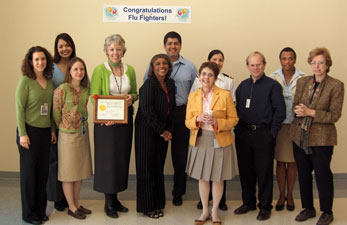 |
|
Social Work Department
|
The "Foil the Flu" campaign ended in March with a record NIH turnout, and on March 29 the CC Hospital Epidemiology Service recognized Clinical Center organizations with 100 percent participation.
The needle was no match for the staff of the Pain and Palliative Care Consult Service (PPCCS), Social Work Department, and the Procedure, Vascular Access and Conscious Sedation Service (PVCS). All three groups were recognized with awards and a pizza lunch for their fearless involvement in this year's flu campaign.
(Top left): Representing the Social Work Department (SWD) are (l to r) Margaret Sarris, Alma Andrade, Ellen Neill, Patricia Prince, Andrea Rander, Rolando Fuentes, Margo Aron, Jeasmine Aizvera, Jonathan White, Adrienne Farrar and Lynda Mullhauser. SWD also thanks the rest of their staff for participating.
(Bottom left): Staff from PPCCS include Eva Cummings, Cynthia Williams, Victoria Bohler, Diane St. Germain, Blythe Edwards, Donna Pereira, Dan Handel and Karen Baker. Not pictured is Dr. Ann Berger.
(Bottom right): From PVCS are (1st row, from l to r) Nena Reed, Pragya Gangele, Jane Moon, Lily Andrade, Anita Marban, (2nd row) Steve Calamuci and Debbie Gutierrez. Not pictured are Peter Christianson, Mash Esfanaji, Annie Gilchrist, Lorraine Hopcroft, Carline Samedy, Kevin Smith, Brigit Thomas, Mara Vecchio and Liz Witter.
|
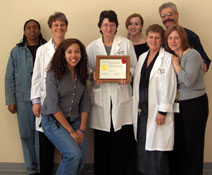
Pain and Palliative Care
Consult Service
|
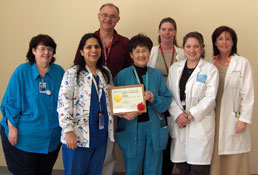
Procedure, Vascular Access and
Conscious Sedation Service
|
Back to Top
Thanks to new labyrinth, relaxation is just steps away
Looking for a different path? Try the labyrinth on 1SE of the Hatfield Center. The 30-foot embossed
canvas path is designed to guide a walk for relaxation, reflection or easy exercise.
A typical journey to the labyrinth's center and back takes about 30 minutes.
The new resource is provided by the CC's Pain and Palliative Care Consult Service (PPCCS), in collaboration with the Spiritual Ministry and Social Work departments and the Recreation Therapy section of the Rehabilitation Medicine Department.
Volunteers and PPCCS staff oversee the labyrinth's assembly, monitor its use and offer instruction for walkers.
Patients and staff are invited to walk the path on the first and third Tuesdays of each month from 8 a.m. to 3 p.m. A tabletop finger labyrinth is also available.
Call the Pain and Palliative Care Consult Service at (301) 594-9767 for more information.
Back to Top
Upcoming Events
May 10 Wednesday
Noon–1 p.m. Lipsett Amphitheater
Contemporary Clinical Medicine: Great Teachers Grand Rounds: Mysterious Cases
Faith Fitzgerald, MD, Assistant Dean of the Humanities and Bioethics, University of California, Davis
May 10 Wednesday
3 p.m. Masur Auditorium
NIH Director's Lecture: Reprogramming of the Immune System
Hermann Waldmann, MB, BChir, PhD, Head, Sir William Dunn School of Pathology, Oxford
May 17 Wednesday
3 p.m. Masur Auditorium
NIH Director's Lecture: Physical Inactivity: The Biggest Public Health Problem of the 21st Century
Steven Blair, PED, President and CEO, The Cooper Institute, Dallas
May 17 Wednesday
Noon–1 p.m. Lipsett Amphitheater
Grand Rounds: Childhood-Onset Obsessive-Compulsive Disorder: Are Contamination Fears Justified?
Susan E. Swedo, MD, Chief, Pediatrics and Developmental Neuropsychiatry Branch, NIMH
Cytokine-Induced Neuropsychiatric Toxicity
Donald Rosenstein, MD, Acting Clinical Director and Chief, Psychiatry Consultation-Liaison Service, NIMH
May 24 Wednesday
Noon–1 p.m. Lipsett Amphitheater
No Grand Rounds
NIH Postbaccalaureate Research Festival
For more information, visit http://preirta.nih.gov/poster_day_2006.asp.
May 24 Wednesday
3 p.m. Masur Auditorium
NIH Director's Lecture
Thea Tlsty, PhD, Professor of Pathology, University of California, San Francisco
May 31 Wednesday
Noon–1 p.m. Lipsett Amphitheater
Grand Rounds: HIV and Other Emerging Causes of Pulmonary Hypertension
Pathophysiology and Clinical Significance in Hemoglobinopathies
Roberto F. Machado, MD, Staff Clinician, Vascular Medicine Branch, NHLBI
HIV and Pulmonary Hypertension: The San Francisco Perspective
Priscilla Hsue, MD, Assistant Professor of Medicine, Division of Cardiology, University of California, San Francisco
Management Strategies
Christopher Barnett, MD, MPH, Fellow, Critical Care Medicine Department, CC
May 31 Wednesday
3 p.m. Masur Auditorium
NIH Director's Lecture: Seeing the Invisible by Solution NMR Spectroscopy
Lewis Kay, PhD, Professor of Medical Genetics, Biochemistry and Chemistry, University of Toronto
To view other NIH and Clinical Center events,
click here
.
Back to Top


 The information on this page is archived and provided for reference purposes only.
The information on this page is archived and provided for reference purposes only.